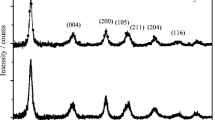Abstract
Sulfur dioxide strongly affects temperature independent resistive oxygen sensors of SrTi1-xFe x O3-δ. Time dependent sensor deterioration was investigated for lanthanum doped SrTi0.65Fe0.35O3-δ (STF35). Parameters were sulfur dioxide concentration, oxygen partial pressure, temperature, and sensor morphology. The sensor poisoning consists of two steps. At lower temperatures sulfur dioxide adsorption and sulfate ion formation at the grain surface is suggested. At higher temperatures the material decomposes into SrSO4, iron depleted STF35, and Fe2TiO5.
Similar content being viewed by others
References
T.Y. Tien, H.L. Stadler, E.F. Gibbons, and P.J. Zacmanidis, Ceram. Bull., 54, 280 (1975).
A. Takami, Ceram. Bull., 67, 1956 (1988).
J. Gerblinger and H. Meixner, J. Appl. Phys., 67, 7453 (1990).
J. Gerblinger, M. Hauser, and H. Meixner, J. Am. Ceram. Soc., 78, 1451 (1995).
T.S. Stefanik and H.L. Tuller, J. Eur. Ceram. Soc., 21, 1967 (2001).
N. Izu, W. Shin, N. Murayama, and S. Kanzaki, Sensors and Actuators B, 93, 449 (2003).
P.T. Moseley and D.E. Williams, Polyhedron, 8, 1615 (1989).
D.E. Williams, B.C. Tofield, P. McGeehin, and Oxygen Sensors, European Patent Specification, EP 0062994 (1982).
R. Moos, W. Menesklou, H.-J. Schreiner, and K.H. Härdtl, Sensors and Actuators B, 67, 178 (2000).
R. Moos, F. Rettig, and C. Plog, Sensors and Actuators B, 93, 42 (2003).
H. Meixner, S. Kornely, D. Hahn, H. Leiderer, B. Lemire, and B. Hacker, Gas Sensor, United States Patent Specification, US 6,101,865 (1995)
F. Rettig, R. Moos, and C. Plog, Sensors and Actuators B, 93, 36 (2003).
L. Wan, “Poisoning of perovskite oxides by sulfur dioxide,” in Properties and Applications of Perovskite-Type Oxides, edited by L.G. Tejuca, and J.L.G.Fierro (Marcel Dekker Inc., New York, USA 1993) p. 145ff.
T. Schulte, R. Waser, E.W.J. Römer, H.J.M. Bouwmeester, U. Nigge, and H.-D. Wiemhöfer, J. Eur. Ceram. Soc., 21, 1971 (2001).
F. Rettig, R. Moos, C. Plog, “Novel temperature independent resistive oxygen sensor without sulfur instability for combustion engine exhausts,” Sensor 2003, in Proceedings of the 11th International Conference, Nürnberg, Germany, 13–15. May 2003, pp. 277–282.
A. Müller and K.H. Härdtl, Appl. Phys. A, 49, 75 (1989).
C. Tragut and K.H. Härdtl, Sensors and Actuators B, 4, 425 (1991).
F.A. Kröger and H.J. Vink, “Relations between the Concentrations of Imperfections in Crystalline Solids,” in, Solid State Physics, edited by F. Seitz, and D. Turnbull (Academic Press, New York, 1956), Vol. 3, pp. 307–435.
Author information
Authors and Affiliations
Corresponding author
Rights and permissions
About this article
Cite this article
Rettig, F., Moos, R. & Plog, C. Poisoning of Temperature Independent Resistive Oxygen Sensors by Sulfur Dioxide. J Electroceram 13, 733–738 (2004). https://doi.org/10.1007/s10832-004-5184-x
Received:
Revised:
Accepted:
Issue Date:
DOI: https://doi.org/10.1007/s10832-004-5184-x



